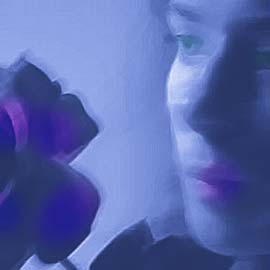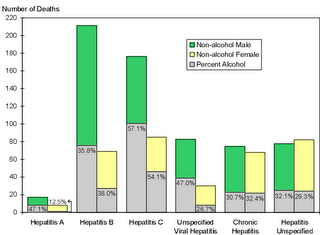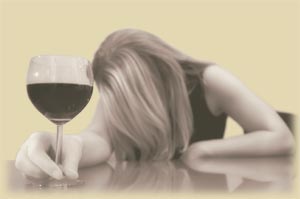
Alcohols usually refer to ethyl alcohol, which are manufactured by the fermentation of the molasses, a byproduct of sugar industry. There are large verities of alcoholic beverages, which are classified as
Alcoholic BeveragesMalted liquors in which alcoholic content low as 3-6%.e.g.Beer, stout.
Wines produced by fermenting of grapes and fruits has content of 9-22% which includes port, cider, champagne etc.
Sprits are alcohols, which are distilled after fermentation, contain 40-60% alcohol content. Examples are wine, whisky, brandy, rum and gin.
Other form of alcohol is absolute alcohol, rectified spirits etc.
Alcohol is primarily a neuronal depressant. Apparent excitation and euphoria are produced at lower plasma concentration. Moderate amount of alcohol drinking has been found responsible for 15-35% lower incidence of coronary heat disease by raising high-density lipids and lowering low-density lipids. Alcohol produces a sense of warmth and help to combat cold and also be reputed as an aphrodisiac.
Diseases caused by alcohol abuseLiver: Alcohol cause fatty change, acute alcohol hepatitis, and cirrhosis of liver. Chronic alcoholism leads to massive enlargement of liver and cellular necrosis.
Nervous System: Ataxia, disturbed cognition, opthalmoplegia, wernicke syndrome and korsakoff syndrome. At conc. 30-100mg/dl of plasma causes excitation and increasing conc. of 100-150mg/dl causes mental clouding, disorganizing of thought and impairment of memory and at 200-300mg/dl stupor and unconsciousness prevails and medullary centers are paralyzed and death may occur.
Heart: Chronic alcoholism causes hypertension and lead to cardiomyopathy. Atrial fibrillation and other cardiac arrhythmias occur.
 Gastrointestinal Tract
Gastrointestinal Tract: Chronic Gastritis, Acute and Chronic pancreatitis are due to alcoholism. Acute pancreatisis is due to heavy drinking.
Skeletal muscle: Alcohol produces a little direct effect. Fatigue is allayed by small doses but weakness pain and myopathy result to chronic alcoholism.
Reproductive system: Though an aphrodisiac, chronic alcohol decreases fertility in both men and women. Testicular atrophy in men and spontaneous abortion in women are some adverse effects seen
Other complicationsFetal alcohol syndrome: It is caused by the maternal consumption of ethanol at levels of only one drink per day. The syndrome produces microcephaly, facial dysmorphology and malformation of brain and growth retardation. This is the most common type of mental retardation in United States and it affects 1200 children per year.
Alcoholic palimpsests: condition seen among alcoholics, behaviour resembling blackouts in anoxaemia. This may result in loss of memory of a period during a drinking spell. Amnesia may be fragmentary or total. During such state a person may perform a criminal act and may not remember after he recovers from intoxication.
Food Value: alcohol requires no digestion and rapidly metabolized producing 7cal/g energy, which cannot be stored. Thus alcohol is an imperfect and expensive food.
Fatal Dose and Period: 150 to 250 ml of absolute alcohol consume in one hour. Fatal period is 12 to 24 hours.
Alcohol addiction and withdrawalAlcolhol addicts are those who cannot stop drinking for long or who experience withdrawal symptom, if they do. It results in impaired social and occupational functioning.
Withdrwal symptom appears after 12-24 hrs after reduction in alcohol intake.
The essential features are tremor of hand tongue and eyelids. In association with nausea and vomiting, malaise weakness tachycardia anxiety hallucination headache and insomnia. Alcoholic treatment of withdrawal symptoms is controlled by chlorodiazepoxide or diazepam.
Alcohol and Traffic accidentsA blood level concentration of 80-100 mg/dl is the legal definition of driving under the influence of alcohol in many states. At or before 100mg all individual are affected and accidents are common, at 150mg driving becomes impaired and 200mg and above most persons are intoxicated and risk of accidents occur.
Alcoholic TreatmentPsychological and medical supportive measures are needed during withdrawal. During past CNS depressants were been used but now benzodiazepines are preferred now. Recent involvement of opioids antagonists in the alcoholic treatment is seen. It has reduced craving and chances of heavy drinking. Naltrexone is approved by US-FDA for use as an adjuvant. Drugs like Disulfiram have an aversion technique in chronic alcoholics.
Safe DrinkingOn average 1-2 drinks per day are safe and not more than 3 drinks on an occasion. Do not engage in hazardous activity or driving after drinking. Safe limits are lower in women because metabolism is slower and bioavailiabilty is higher in women.
Note 1 drink = 50ml of spirits = 150ml of wines = 400ml of beer all have 18-20 g of alcohol.
Alcoholic rehabilitationAlcoholics Anonymous is an international voluntary agency which has branches throughout everywhere. It consist of mainly ex-alcoholics who usually meet once a week, share their experience and try to encourage one another to abstain from alcohol.




